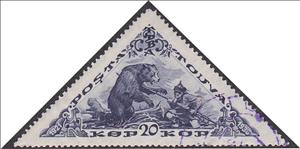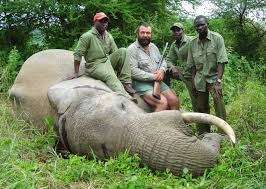Stamp: Hunter and bear (Tannu Tuva 1936)
Hunter and bear (Tannu Tuva 1936)
01 January (Tannu Tuva ) within release 15th Anniversary of Independence goes into circulation Stamp Hunter and bear face value 20 Tuvan kepejek
| Stamp Hunter and bear in catalogues | |
|---|---|
| Stamp Number: | Sn:TX 81 |
| Michel: | Mi:TX 86C |
Stamp is horizontal format.
Also in the issue 15th Anniversary of Independence:
- Stamp - Coat of arms of Tuva Arat Republic (TAR) face value 1;
- Stamp - Sat Churmit-Dazhy (1894-1938) face value 2;
- Stamp - Bactrian Camel (Camelus bactrianus), Native face value 3;
- Stamp - Wrestling face value 4;
- Stamp - Archer face value 5;
- Stamp - Wrestling face value 6;
- Stamp - Archer face value 8;
- Stamp - Spearfishing face value 10;
- Stamp - Hunter and bear face value 12;
- Stamp - Spearfishing face value 15;
- Stamp - Hunter and bear face value 20;
- Stamp - Boy riding yak face value 25;
- Stamp - Bactrian Camel (Camelus bactrianus), Train face value 30;
- Stamp - Boy riding yak face value 35;
- Stamp - Horse race face value 40;
- Stamp - Horse race face value 50;
- Stamp - Archery competition face value 70;
- Stamp - Freedom fighters face value 80;
- Stamp - Tuvan soldiers face value 1;
- Stamp - Tuvan soldiers face value 2;
- Stamp - “Confiscation of cattle from people's enemies” face value 3;
- Stamp - Scene from the freedom fight face value 5;
Stamp Hunter and bear it reflects the thematic directions:
Bears are carnivoran mammals of the family Ursidae (/ˈɜːrsɪdiː, -daɪ/). They are classified as caniforms, or doglike carnivorans. Although only eight species of bears are extant, they are widespread, appearing in a wide variety of habitats throughout most of the Northern Hemisphere and partially in the Southern Hemisphere. Bears are found on the continents of North America, South America, and Eurasia. Common characteristics of modern bears include large bodies with stocky legs, long snouts, small rounded ears, shaggy hair, plantigrade paws with five nonretractile claws, and short tails.
Hunting is the human practice of seeking, pursuing, capturing, or killing wildlife or feral animals. The most common reasons for humans to hunt are to exploit the animal's body for meat and useful animal products (fur/hide, bone/tusks, horn/antler, etc.), for recreation/taxidermy (see trophy hunting), although it may also be done for non-exploitative reasons such as removing predators dangerous to humans or domestic animals (e.g. wolf hunting), to eliminate pests and nuisance animals that damage crops/livestock/poultry or spread diseases (see varminting), for trade/tourism (see safari), or for ecological conservation against overpopulation and invasive species.
The Kionga Triangle (German: Kionga-Dreieck, Portuguese: Triângulo de Quionga) was a small region of German East Africa situated at the mouth of the Ruvuma River. The Ruvuma served as the border between the German colony and Portuguese Mozambique, and the Kionga Triangle was the only section of German East Africa south of the river. Its principal settlement was Kionga (now Quionga ) which had a population of 4,000 in 1910. It became a German possession in 1894 but came under Portuguese control in April 1916 during World War I. The post-war Treaty of Versailles reaffirmed that the river was the border between Tanganyika, then under British control, and Portuguese Mozambique. The triangle was the only territory that the treaty awarded to Portugal.


